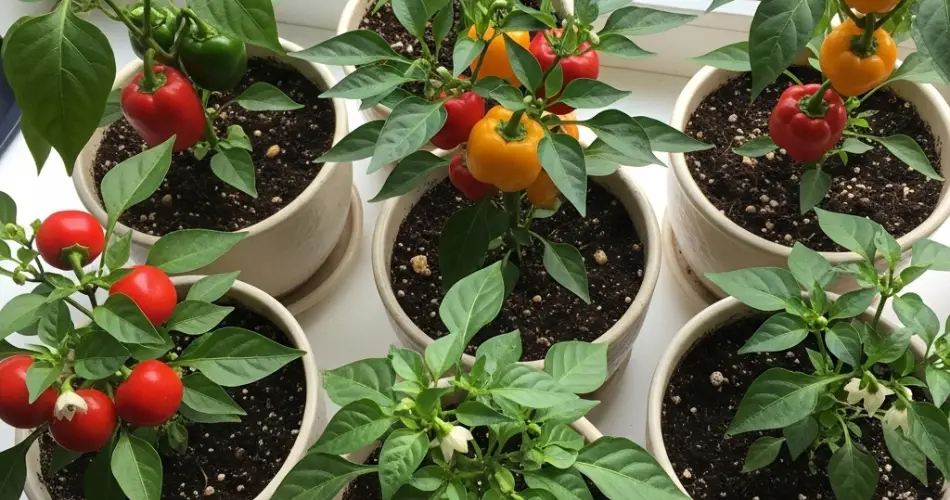Peppers are among the most satisfying vegetables to grow in containers. Whether you prefer sweet bell peppers or fiery chili varieties, they thrive in pots and bring both flavor and color to your patio, balcony, or windowsill. Even if you’re short on space, you can grow robust pepper plants with minimal equipment and enjoy fresh harvests for months.
This guide covers everything you need to know to successfully grow pepper plants in containers—from choosing the right pot and soil to caring for your plants and harvesting the fruits.
Why Grow Peppers in Containers?
Peppers are ideal for container gardening. They don’t require deep soil like root crops and are fairly compact, making them a good choice for patios, balconies, and other small areas. Container gardening also helps reduce the risk of soil-borne diseases and makes pest control easier.
Benefits of container-grown peppers include:
-
Flexibility to move plants to sunnier or more protected spots
-
Greater control over soil quality and moisture levels
-
Easier access for watering and pruning
-
A beautiful addition to your outdoor space with their bright fruits and lush foliage
Choosing the Right Pepper Variety
Many types of peppers adapt well to pots. If you’re limited on space, select compact or dwarf varieties. If you have a larger patio or can manage deeper containers, you can grow standard bell peppers or hot chilies.
Popular pepper varieties for containers:
-
Mini Bell Peppers – Small and sweet, great for tight spaces
-
Cayenne – Slim, spicy peppers that grow in abundance
-
Jalapeño – Popular medium-heat variety that thrives in pots
-
Banana Peppers – Mild and tangy, easy to grow
-
Thai Chili – Compact and productive with fiery heat
-
Lunchbox Peppers – Small, snack-sized fruits in a range of colors
What You’ll Need
To grow peppers successfully in containers, gather these essentials:
-
Container: At least 3–5 gallons in size with good drainage holes
-
Potting mix: Loose, well-draining soil designed for vegetables
-
Compost or aged organic matter to enrich the soil
-
Pepper seedlings or seeds
-
A sunny location: At least 6–8 hours of direct sun daily
-
Watering can or hose with gentle spray
-
Support stakes or cages (for larger pepper varieties)
Planting Peppers in Containers
-
Prepare the Container
Choose a pot with a minimum depth of 10–12 inches. Fill it with a high-quality potting mix blended with compost. Avoid using garden soil, which can compact and restrict root growth. -
Plant Your Pepper
-
If using seedlings, plant them at the same depth as they were in their nursery pots.
-
If sowing from seed, follow packet instructions and ensure consistent warmth and moisture until germination.
-
For each 5-gallon container, plant one pepper plant to give roots room to expand.
-
-
Water After Planting
Water thoroughly until moisture runs out the bottom of the pot. This settles the soil around the roots.
Light and Temperature Requirements
Peppers are heat-loving plants. They thrive in temperatures between 70–85°F (21–29°C) during the day and 60–70°F (15–21°C) at night. Position your container in the sunniest part of your patio. If temperatures drop, consider moving the pot indoors or covering the plant at night.
Ongoing Care
-
Watering: Keep the soil consistently moist but not soggy. Peppers don’t like wet feet or dried-out soil. In hot weather, you may need to water daily.
-
Feeding: After the plant is established, apply a balanced liquid fertilizer every 2–3 weeks or use a slow-release organic fertilizer at planting time.
-
Support: Tall pepper varieties may need a stake or cage to keep the branches upright when fruit begins to form.
-
Pruning: Pinch off the first few flowers to encourage stronger root and leaf development early in the season.
Pests and Problems
Container-grown peppers are generally less prone to issues, but keep an eye out for:
-
Aphids and spider mites: Remove with insecticidal soap or neem oil.
-
Blossom end rot: Usually caused by inconsistent watering or calcium deficiency. Maintain even moisture and use a calcium-rich fertilizer if needed.
-
Fungal issues: Ensure proper air circulation around plants and avoid watering the foliage.
Harvesting Peppers
Peppers can be harvested when they reach full size and color, depending on the variety. Most peppers start green and turn red, orange, yellow, or purple as they ripen. Use scissors or pruning shears to snip fruits cleanly from the plant to avoid damaging stems.
You can harvest peppers when they are immature for a milder flavor or wait until fully ripe for sweetness or maximum heat, depending on the variety.
Final Thoughts
Growing peppers on your patio is a rewarding way to enjoy fresh, flavorful produce with minimal space. With bright sunlight, regular watering, and occasional feeding, your pepper plants will thrive in containers and provide a steady harvest throughout the growing season.
Whether you’re growing sweet peppers for salads or hot chilies for cooking, container gardening gives you full control and flexibility. Add a pot or two of peppers to your patio garden this season, and enjoy the vibrant results from your own harvest.



